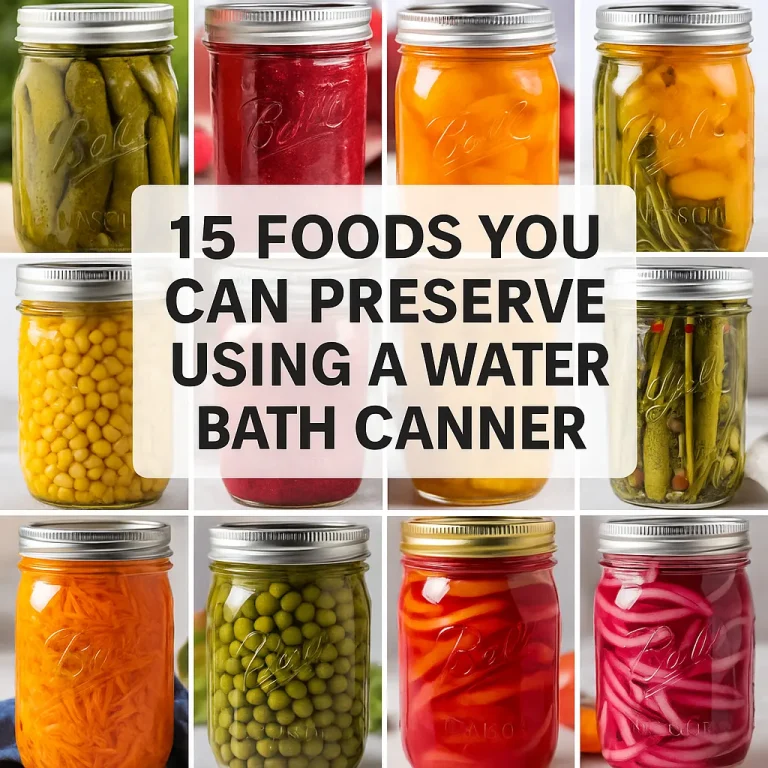A Taste of Summer in a Jar: Why Water Bath Canning Still Matters
Imagine opening a jar of homemade peach preserves in the middle of winter. One spoonful transports you back to sunny afternoons and overflowing baskets of ripe fruit. That’s the magic of water bath canning. This age-old food preservation method allows you to capture freshness, reduce food waste, and stock your pantry with shelf-stable, home-canned goodness. If you grow your own produce or want more control over your food supply, learning what foods you can preserve using a water bath canner can transform how you cook, store, and prepare meals.

Why Water Bath Canning Deserves a Spot in Every Home
Water bath canning is simple, accessible, and deeply rewarding. Whether you’re a homesteader, a weekend gardener, or a prepper building food security, this technique offers freedom to preserve seasonal foods with confidence. It’s among the most beginner-friendly canning methods for long-term storage.
👉 If you’re looking to master food preservation and live more self-sufficiently, check out The Self-Sufficient Backyard. It’s a comprehensive guide for growing, storing, and preserving food—even if you’re working with a small backyard or limited space.
What Is Water Bath Canning and How Does It Work?
A Gentle But Powerful Food Preservation Method
Water bath canning involves submerging jars of food in boiling water for a specific time. This safe home canning method is ideal for high-acid foods, as the acidity and heat kill harmful bacteria, molds, and yeasts.
- Boiling Point: 212°F (100°C) at sea level
- Vacuum Seal: Prevents air from re-entering and ensures shelf stability
- Best For: High-acid foods with a pH of 4.6 or lower
Why High-Acid Foods Work Best
The acidity (natural or added) makes foods safe for water bath canning by preventing the growth of Clostridium botulinum, the bacteria that cause botulism. For low-acid foods like plain vegetables and meats, use pressure canning instead.
With this method, you can safely store jams, jellies, pickles, and other fruit- or vinegar-based recipes without refrigeration.
15 Foods You Can Preserve Using a Water Bath Canner
Let’s explore the top foods to preserve with a water bath canner. These options are flavorful, versatile, and ideal for beginner canners.
Fruits and Fruit-Based Preserves

- Strawberries – Make jams, jellies, or compotes. Add lemon juice to boost acidity.
- Peaches – Preserve in syrup, pie filling, or peach butter.
- Apples – Use for applesauce, apple butter, or spiced chutneys.
- Blueberries – Create jam, syrup, or blueberry butter.
- Cherries – Ideal for preserves, dessert fillings, and sauces.
- Tomatoes – Safely can whole, crushed, or as salsa with added acid.
Sweet & Savory Condiments

- Salsa – Use vinegar or lemon juice to make tomato salsa safe for canning.
- Pickled Beets – Bright, tangy, and long-lasting.
- Relishes – Cucumber or zucchini relish with vinegar and sugar.
- Chutneys – Fruit and vinegar-based condiments with spices.
- Fruit Butters – Slow-cooked spreads like apple or pear butter.
Pickles and Preserved Vegetables

- Cucumber Pickles – Garlic dill or sweet pickles made with vinegar.
- Pickled Carrots – Great for snacking and preserving crunch.
- Pickled Peppers – Banana, bell, or jalapeño varieties in vinegar.
- Pickled Onions – Use red or pearl onions for zesty toppings.
🌿 Recommended Resource: The Self-Sufficient Backyard
Want to take your food preservation journey even further? The Self-Sufficient Backyard is a detailed, practical guide written by a couple living completely off-grid. It covers everything from growing your own food and harvesting rainwater to preserving produce using water bath canning, drying, and root cellaring.
✅ Perfect for beginners and seasoned preppers alike
✅ Learn how to preserve food safely without electricity
✅ Includes actionable tips for turning your space into a mini-homestead
👉 Grab your copy of The Self-Sufficient Backyard now and start building your resilient food system.
What You Need for Successful Water Bath Canning
Essential Water Bath Canning Equipment
- Large water bath canner or deep stockpot with lid and rack
- Mason jars with two-piece lids
- Jar lifter, funnel, bubble remover
- Towels, ladle, large mixing pot
Safety Tips for Water Bath Canning
- Only use tested recipes (Ball, USDA, NCHFP)
- Sterilize jars before canning
- Add lemon juice or vinegar to borderline acidic foods
- Never attempt to can low-acid foods without a pressure canner
Easy Recipe Ideas to Preserve Using a Water Bath Canner
- Strawberry Jam

— Combine strawberries, sugar, and lemon juice. Cook until thick and jar. Process for 10–15 minutes.
- Pickled Beets

— Boil and peel beets, then pack them in a vinegar-sugar-spice brine. Process jars for 30–35 minutes.
- Apple Butter

— Cook apples with cinnamon and sugar until thick. Fill jars and process for 10–15 minutes.
- Dill Pickles

— Soak cucumbers in ice water, then pack them with garlic, dill, and vinegar. Process for 10 minutes.
- Tomato Salsa

— Mix tomatoes, onions, and peppers with added vinegar or lemon juice. Process for 15–20 minutes.
These are just a few examples of foods you can preserve using a water bath canner for delicious, long-lasting results.
FAQ – Foods You Can Preserve Using a Water Bath Canner
What are the best foods to preserve using a water bath canner?
Fruits, jams, jellies, salsas, pickles, and relishes made with added vinegar or lemon juice are ideal for water bath canning.
Can I can vegetables with a water bath canner?
Only if they are pickled using vinegar. Low-acid vegetables must be preserved using a pressure canner.
How long do water bath canned foods last?
When stored properly, water bath canned foods can last 12–18 months in a cool, dark place.
What’s the main difference between water bath and pressure canning?
Water bath canning is for high-acid foods and uses boiling water. Pressure canning is needed for low-acid foods and uses higher heat.
Do tomatoes need added acid?
Yes. Always add bottled lemon juice or vinegar to tomatoes to ensure safe preservation via water bath canning.
Build Your Pantry with Water Bath Canning
By understanding which foods you can preserve using a water bath canner, you gain control over your pantry, reduce dependency on store-bought goods, and celebrate the flavors of every season. Water bath canning is a foundational food preservation method every home cook and prepper should master.
Start with easy canning recipes like jams and pickles. Use safe, tested guidelines. Then experiment with relishes, fruit butters, and salsas to add variety to your food storage.
Water bath canning empowers you to create a self-reliant, shelf-stable kitchen—one jar at a time.
🌱 Ready to make the most of your backyard harvest? Click here to get The Self-Sufficient Backyard and discover time-tested methods to preserve food, live sustainably, and thrive off the land.

